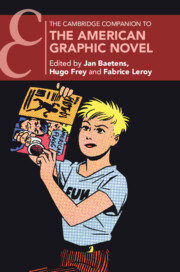Book contents
- The Cambridge Companion to the American Graphic Novel
- The Cambridge Companion to the American Graphic Novel
- Copyright page
- Contents
- Figures
- Contributors
- Editors’ Acknowledgments
- Introduction
- Part I History and Genre
- Part II Graphic Novels and the Quest for an American Diversity
- 10 Expressions of Jewishness alongside Grief in American Graphic Novels
- 11 Black Looking and Looking Black
- 12 African American New History-Writing in Graphic Narratives
- 13 Coming to America, “Land of the Free”
- 14 Spatiotemporal Projections
- 15 Queer Graphic Novels
- 16 American Women’s Lives in Graphic Novels
- Index
- Cambridge Companions To …
- References
11 - Black Looking and Looking Black
African American Cartoon Aesthetics
from Part II - Graphic Novels and the Quest for an American Diversity
Published online by Cambridge University Press: 10 January 2024
- The Cambridge Companion to the American Graphic Novel
- The Cambridge Companion to the American Graphic Novel
- Copyright page
- Contents
- Figures
- Contributors
- Editors’ Acknowledgments
- Introduction
- Part I History and Genre
- Part II Graphic Novels and the Quest for an American Diversity
- 10 Expressions of Jewishness alongside Grief in American Graphic Novels
- 11 Black Looking and Looking Black
- 12 African American New History-Writing in Graphic Narratives
- 13 Coming to America, “Land of the Free”
- 14 Spatiotemporal Projections
- 15 Queer Graphic Novels
- 16 American Women’s Lives in Graphic Novels
- Index
- Cambridge Companions To …
- References
Summary
This chapter examines how people of the Black diaspora in the United States have articulated their histories and experiences in comics and graphic novels, and how they have developed singular aesthetic strategies to counter a white comics imaginary and its stereotyped depiction of Black bodies and culture, in order to construct more accurate images of themselves. This includes revisiting American history – particularly enslavement and Civil Rights activism – through a Black lens and with Black readers in mind. This historical rewriting engages with the social, political, and cultural contributions of Black people, filling voids and questioning occlusions. The chapter studies groundbreaking works of this nature by authors such as Kyle Baker, Roland and Taneisha Laird, and Joel Christian Gill. It also highlights the importance of graphic novels depicting the Black communal experience in the context of resistance to violence and the fight for social justice. Finally, it discusses the importance of Black embodiment and the embracing of Black culture, from early works such as Jackie Ormes’s strips in the 1950s to contemporary graphic novels like Ebony Flowers’s Hot Comb (2019).
Keywords
- Type
- Chapter
- Information
- The Cambridge Companion to the American Graphic Novel , pp. 193 - 209Publisher: Cambridge University PressPrint publication year: 2023



